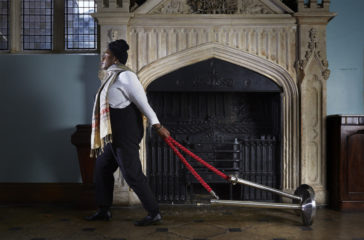"How are different voices involved in both defining and creating better futures?"
“Positioning this year’s IBT festival as ‘a gathering’ that facilitates the sharing of knowledge, space for new dialogues and the potential for encounters, is indicative of a movement to shift current models of cultural production away from affirming exponential growth, productivity narratives and the broader context of what philosopher Saskia Sassen terms ‘extractive capitalism’ – the ideologies that have led us to environmental collapse, economic and social inequality. Moving from a space of (re)presentation towards a space of action is not to necessarily dismiss the cultural relevance of high production, slick, big budget artworks (because they also give us iconic imagery, inspiration and afford a space for dreaming… maybe about different futures?), instead, the framing of In Between Time as a ‘summit’ demands that actually, in order to address global infrastructural problems, we need to prioritise resources for addressing injustice, ensure that we deploy more equitable ways of working and living, and support the emergence of new forms of organising and acting. In other words, in response to the key question of the In Between Time Summit “How do we build a better future?” I think the answers are resources, methods and visions. It sounds so worthy and right on, how could you disagree, right?
"I think the answers are resources, methods and visions. It sounds so worthy and right on, how could you disagree, right?"
But most of all, in order to build better and multiple futures, we need to focus on people. Futurology as a strategic business discipline within the Anglo-European context, is one that has historically been occupied by and with perspectives of white middle-class men, such as Joseph Voros who conceptualised the much-quoted Futures Cone. Similarly, in the context of climate change activism, movements such as Extinction Rebellion are dominated by white cis able-bodied middle-class people, which results in amplifying those identities, to the erasure of viewpoints from communities of colour and the Global South, who are disproportionately at risk and effected by both criminalisation and environmental devastation. It’s clear that in our current re-evaluations of what it means to make futures, there should be an unpacking of the privileges and values that underpin these dominating perspectives: how are different voices involved in both defining and creating better futures?
Challenging and undoing ‘paternalism’ (as a patriarchal, colonialist set of technologies) towards individuals from marginalised backgrounds and identities, is fundamental to creating a more equitable society – a society where marginalised and underrepresented communities can self-determine new futures. Critical understanding and engagement with the impacts of institutional racism (beyond the discourse of ‘cultural competence’ or ‘cultural awareness’ that often prioritise comfort of white perspectives and so result in reiterating Otherness), is required to address the embedded, entangled colonialist perspectives that remain at the foundations of every sector of society. This is why organisations and institutions need to commit to deep and ongoing Equality, Diversity and Inclusion work: we need to have real talk about what institutional racism looks like, the impacts of racism and discrimination, and take action to dismantle it. The Trade Union Congress recently conducted a study called ‘Racism Ruins Lives’, noting the “accumulative effect that institutional racism has on BAME (Black, Asian and Minority Ethnic) workers health and wellbeing”. Similarly, research undertaken by the CIPD found that BAME employees “do not feel valued or inspired. In particular, BAME employees are particularly dissatisfied with their experiences of management and career progression.”
In the fields of arts and culture, Arts Council England’s wide-ranging initiative The Creative Case for Diversity has put questions of diversity and inclusion at the heart of cultural production in England. We are starting to see its impacts, with artists from underrepresented communities increasingly being supported and their work presented on major UK platforms. The issue of representation has been discussed by The White Pube (with their usual verve). It’s not enough for artists and arts workers from BAME backgrounds to have a seat at the table now: let’s delve deeper to ask, how does this table operate? Does it serve the requirements of people from marginalised communities? If the table is not fit for purpose, is a change in the construction of the table required? Or is a table necessary at all?!
"It’s not enough for artists and arts workers from BAME backgrounds to have a seat at the table now: let’s delve deeper to ask, how does this table operate? Does it serve the requirements of people from marginalised communities? If the table is not fit for purpose, is a change in the construction of the table required? Or is a table necessary at all?!"
As well, there is a great call for space so that BAME folks who have experienced injustices can heal, but also play and create, in ways that encompass more than the discrimination and traumas they have experienced. Many existing schemes and opportunities for ‘diverse’ individuals to become leaders focus on integrating artists and arts workers of colour into normative and hegemonic power structures, without regard for the knowledge these individuals can and already do contribute to the cultural sphere. If BAME artists and arts workers are to be seen and understood as the individuals they are, rather than tokens valued for their identities, then complementary spaces, defined and developed by BAME artists and arts workers themselves, need to be supported and facilitated. As the legendary Black American writer Toni Morrison pointed out, racism is a “distraction. It keeps you from doing your work.”
Whilst ameliorative or therapeutic restoration of well-being for individuals who have experienced discrimination is extremely valuable, a number of advocates within the healthcare sector are now recognising the limitations of such trauma-informed care approaches. For instance, Black youth development activist and academic Dr Shawn Ginwright states,, “if trauma is collectively experienced, this means that we also have to consider the environmental context that caused the harm in the first place. By only treating the individual we only address part of the equation leaving the toxic systems, policies and practices neatly intact.” BAME artists and arts workers should be resourced to create opportunities for their self-development, on their own terms.
"BAME artists and arts workers should be resourced to create opportunities for their self-development, on their own terms."
Initiatives like the Live Art UK programme Diverse Actions, supported through Arts Council England’s Ambition for Excellence fund, go some ways towards addressing the lack of self-determined opportunities for BAME artists and arts workers. Through supporting new artistic works, leadership awards, development bursaries and the professional development workshops led by artists for artists, Diverse Actions facilitates vital space for BAME artists and arts workers to platform the diversity of their work and approaches. For instance, Barby Asante and Ria Hartley’s 2018 DIY project ‘The Body is the Place. Memories are the Map’ invited an intergenerational group of artists and arts workers of colour to collectively explore how ancestral histories, biography and archive appear and are processed by artists in their work. Similarly, the nascent ‘Black Joy’ project, led by Tarik Elmoutawakil who is director of Brighton’s LGBTQ+ friendly Marlborough Pub and Theatre, aims to centre, celebrate and explore joyful aspects of Black experience, through new work and critical reflections. Both of these Diverse Actions projects create spaces that are specifically for BAME artists and arts workers, and it is important that such closed spaces exist. These spaces (and others like them) give artists and arts organisers of colour the opportunities to self-narrate their experiences (including but not exclusively of prejudice, discrimination and racism); develop their creative practices in supportive contexts; articulate how they want their work to be evaluated and contextualised; and perhaps crucially, to have fun with others, without being the only brown or black face in the room.
In Between Time this year will feature one such space, the Creative Exchange Lab, which will bring together a group of 14 artists of colour, selected via an open call. Funded by the Diverse Actions programme, artists participating in the Lab come from across the UK, all with different experiences of being an artist but who share a motivation to deepen their encounters with activism, radical creativity and Live Art. In Between Time Summit artists Dorothée Munyaneza, Kameelah Janan Rasheed and Cigdem Aydemir will be leading 2 day creative workshops as the central part of the Lab, and I am excited to conduct a mentoring session with each participating artist. The Creative Exchange Lab aims to provide a dynamic space that is not geared towards production and presentation of a new work but on nurturing, researching, experimenting, working together and taking risks as a temporary community – echoing the scientific origins of the term ‘laboratory’.
"The Creative Exchange Lab aims to provide a dynamic space that is not geared towards production and presentation of a new work but on nurturing, researching, experimenting, working together and taking risks as a temporary community"
As a researcher and independent curator, I consider that mentoring and curating go hand in hand. Mentoring has become increasingly more important to my practice, particularly as someone working in the field of Live Art and performance, as a curatorial act of care: care for the labour of performing, in the face of liveness. In these unstable times, when we are overloaded with information and events moving at lightspeed, mentoring attempts to provide a space for listening, reflection and making sense. Doubly so for BAME artists, in a landscape where mentors are still predominantly white, and support structures for BAME artists are still emerging. Supporting BAME artists and creative practitioners to reflect, rebuild and resist issues of inequality and precarity in the arts and culture sector is the focus of my Arts Council England Developing Your Creative Practice award, in which I will be exploring intersectional forms of artist support and curatorial practice. Inspired by the card I took away from Selina Thompson’s epic work ‘Race Cards’, folding decolonising perspectives into the act of mentoring is part of what I hope to bring to In Between Time’s Creative Exchange Lab.”
Dr Cecilia Wee fRSA is a curator and researcher who grew up in Thatcher’s London, working with experimental sound, performance, visual art and design practices, passionate about addressing issues of inequality and precarity in the cultural sector and beyond. Cecilia is Chair of the Live Art Development Agency.
CECILIA WEE © LOUIS SCHREYER









